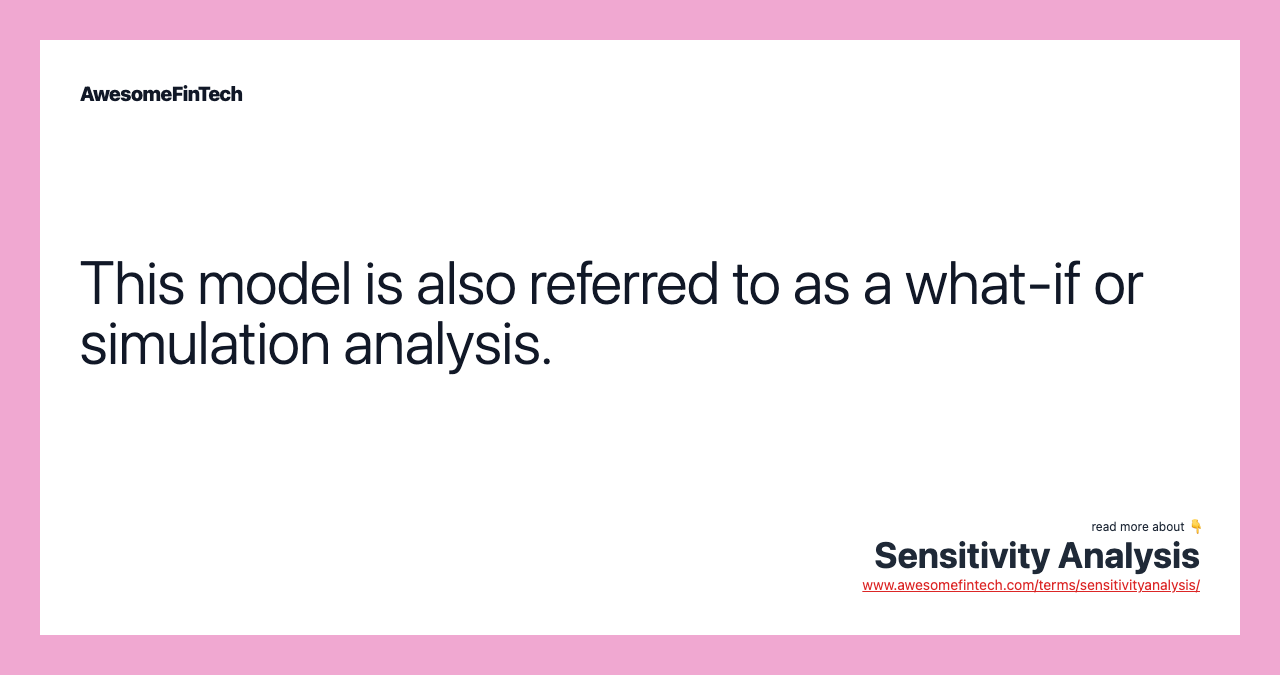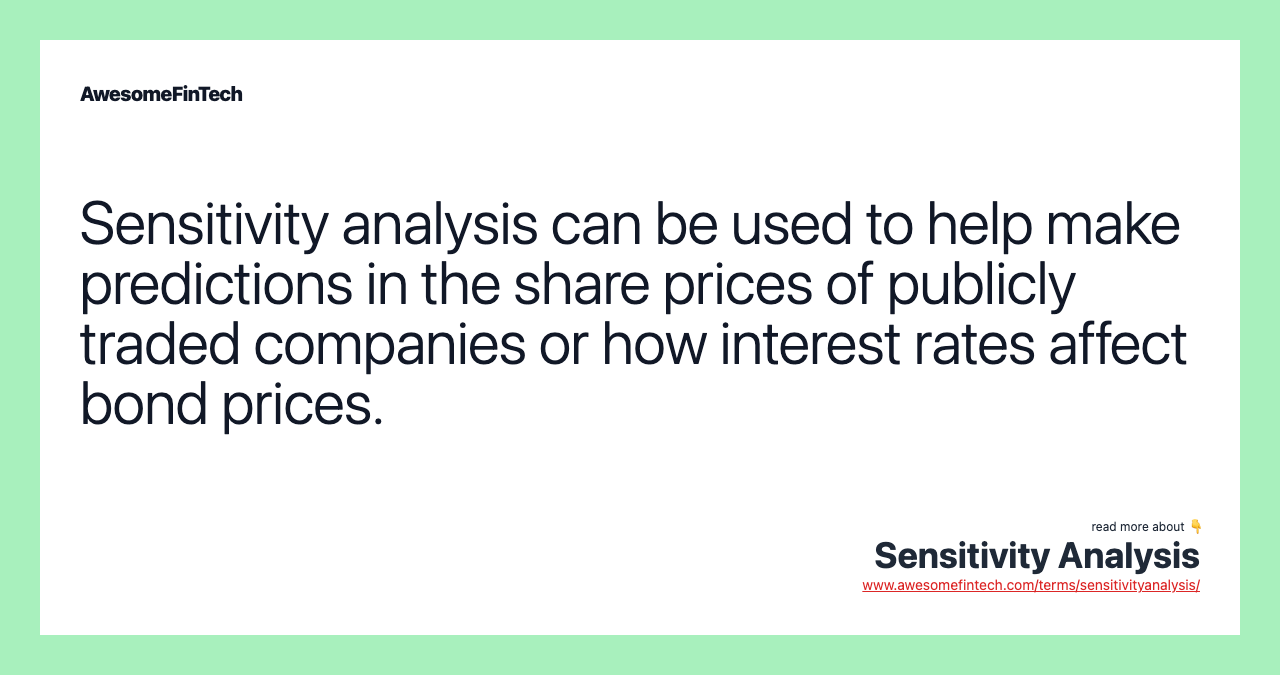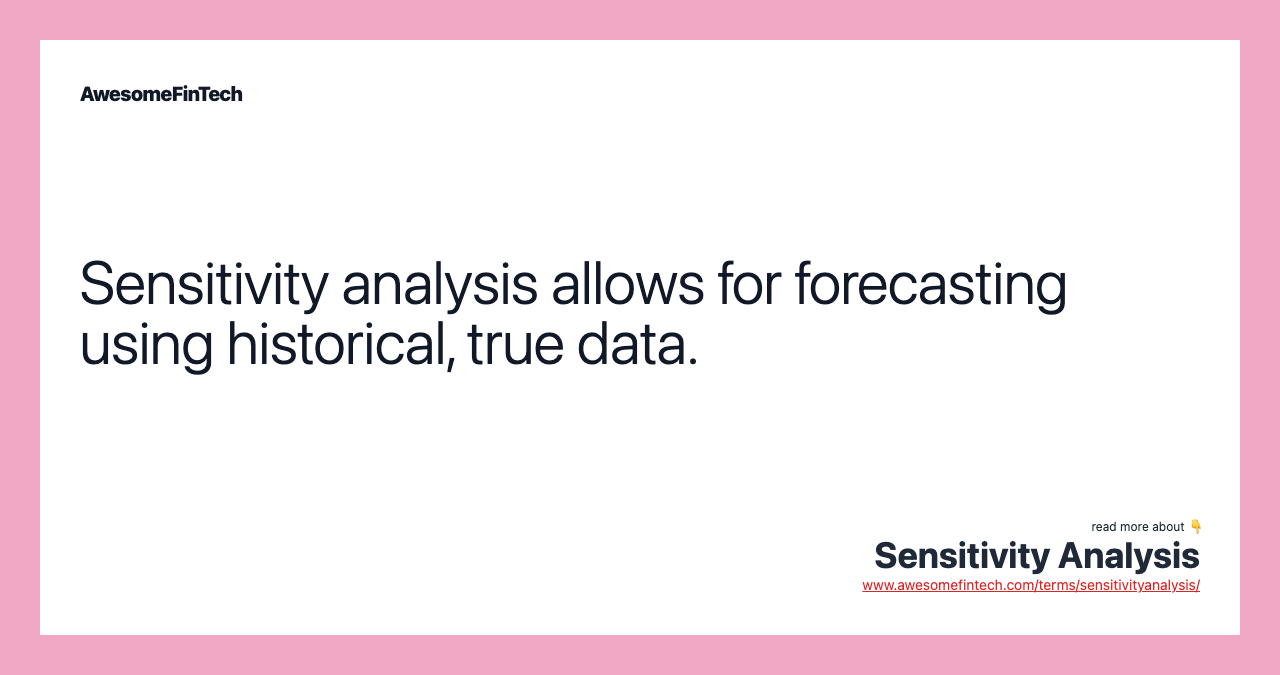Sensitivity Analysis
Sensitivity analysis determines how different values of an independent variable affect a particular dependent variable under a given set of assumptions. Sensitivity analysis is a financial model that determines how target variables are affected based on changes in other variables known as input variables. The sensitivity analysis is based on the variables that affect valuation, which a financial model can depict using the variables' price and EPS. As an example, assume an equity analyst wants to do a sensitivity analysis and a scenario analysis around the impact of earnings per share (EPS) on a company's relative valuation by using the price-to-earnings (P/E) multiple. Sensitivity analysis determines how different values of an independent variable affect a particular dependent variable under a given set of assumptions.

What Is Sensitivity Analysis?
Sensitivity analysis determines how different values of an independent variable affect a particular dependent variable under a given set of assumptions. In other words, sensitivity analyses study how various sources of uncertainty in a mathematical model contribute to the model's overall uncertainty. This technique is used within specific boundaries that depend on one or more input variables.
Sensitivity analysis is used in the business world and in the field of economics. It is commonly used by financial analysts and economists and is also known as a what-if analysis.




How Sensitivity Analysis Works
Sensitivity analysis is a financial model that determines how target variables are affected based on changes in other variables known as input variables. This model is also referred to as what-if or simulation analysis. It is a way to predict the outcome of a decision given a certain range of variables. By creating a given set of variables, an analyst can determine how changes in one variable affect the outcome.
Both the target and input — or independent and dependent — variables are fully analyzed when sensitivity analysis is conducted. The person doing the analysis looks at how the variables move as well as how the target is affected by the input variable.
Sensitivity analysis can be used to help make predictions about the share prices of public companies. Some of the variables that affect stock prices include company earnings, the number of shares outstanding, the debt-to-equity ratios (D/E), and the number of competitors in the industry. The analysis can be refined about future stock prices by making different assumptions or adding different variables. This model can also be used to determine the effect that changes in interest rates have on bond prices. In this case, the interest rates are the independent variable, while bond prices are the dependent variable.
Investors can also use sensitivity analysis to determine the effects different variables have on their investment returns.
Sensitivity analysis allows for forecasting using historical, true data. By studying all the variables and the possible outcomes, important decisions can be made about businesses, the economy, and making investments.
Example of Sensitivity Analysis
Assume Sue is a sales manager who wants to understand the impact of customer traffic on total sales. She determines that sales are a function of price and transaction volume. The price of a widget is $1,000, and Sue sold 100 last year for total sales of $100,000. Sue also determines that a 10% increase in customer traffic increases transaction volume by 5%. This allows her to build a financial model and sensitivity analysis around this equation based on what-if statements. It can tell her what happens to sales if customer traffic increases by 10%, 50%, or 100%. Based on 100 transactions today, a 10%, 50%, or 100% increase in customer traffic equates to an increase in transactions by 5%, 25%, or 50% respectively. The sensitivity analysis demonstrates that sales are highly sensitive to changes in customer traffic.
Sensitivity vs. Scenario Analysis
In finance, a sensitivity analysis is created to understand the impact a range of variables has on a given outcome. It is important to note that a sensitivity analysis is not the same as a scenario analysis. As an example, assume an equity analyst wants to do a sensitivity analysis and a scenario analysis around the impact of earnings per share (EPS) on a company's relative valuation by using the price-to-earnings (P/E) multiple.
The sensitivity analysis is based on the variables that affect valuation, which a financial model can depict using the variables' price and EPS. The sensitivity analysis isolates these variables and then records the range of possible outcomes.
On the other hand, for a scenario analysis, the analyst determines a certain scenario such as a stock market crash or change in industry regulation. He then changes the variables within the model to align with that scenario. Put together, the analyst has a comprehensive picture. He now knows the full range of outcomes, given all extremes, and has an understanding of what the outcomes would be, given a specific set of variables defined by real-life scenarios.
Benefits and Limitations of Sensitivity Analysis
Conducting sensitivity analysis provides a number of benefits for decision-makers. First, it acts as an in-depth study of all the variables. Because it's more in-depth, the predictions may be far more reliable. Secondly, It allows decision-makers to identify where they can make improvements in the future. Finally, it allows for the ability to make sound decisions about companies, the economy, or their investments.
But there are some disadvantages to using a model such as this. The outcomes are all based on assumptions because the variables are all based on historical data. This means it isn't exactly accurate, so there may be room for error when applying the analysis to future predictions.
Related terms:
Business Valuation , Methods, & Examples
Business valuation is the process of estimating the value of a business or company. read more
Coefficient of Determination: Overview
The coefficient of determination is a measure used in statistical analysis to assess how well a model explains and predicts future outcomes. read more
Debt-to-Equity (D/E) Ratio & Formula
The debt-to-equity (D/E) ratio indicates how much debt a company is using to finance its assets relative to the value of shareholders’ equity. read more
Economics : Overview, Types, & Indicators
Economics is a branch of social science focused on the production, distribution, and consumption of goods and services. read more
Earnings Per Share (EPS)
Earnings per share (EPS) is the portion of a company's profit allocated to each outstanding share of common stock. Earnings per share serve as an indicator of a company's profitability. read more
Financial Modeling
Financial modeling is the process of creating a summary of a company's costs and income in the form of a spreadsheet that can be used to calculate the impact of a future event or decision. read more
Hedonic Regression
Hedonic regression applies regression analysis to estimate the relative impact of the variables that affect the price of a good or service. read more
Public Company
A public company is a corporation whose ownership is distributed amongst general public shareholders through publicly-traded stock shares. read more
Regression
Regression is a statistical measurement that attempts to determine the strength of the relationship between one dependent variable (usually denoted by Y) and a series of other changing variables (known as independent variables). read more
Scenario Analysis
Scenario analysis is the process of estimating the expected value of a portfolio after a given change in the values of key factors take place. read more